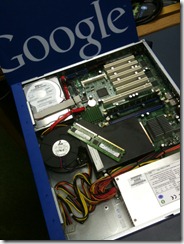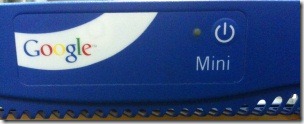GoogleMini Search Appliance Fails to Boot
 A sinking feeling washes over as the network monitor alerts you to a lost server, a bit like loosing contact with one of the fleet at sea. Today it is the GoogleMini, purchased to quickly give us good, familiar search results to our externally facing websites a couple of years ago.
A sinking feeling washes over as the network monitor alerts you to a lost server, a bit like loosing contact with one of the fleet at sea. Today it is the GoogleMini, purchased to quickly give us good, familiar search results to our externally facing websites a couple of years ago.
Support Policy
The GoogleMini comes with a maximum of two years support. After that time, if support renewal is required then you must accept a new GoogleMini to go with it. A free box with your support contract is better way of thinking of the way Google run the support and less painful than thinking about how every two years another 1U sever is going to be scrapped. The typical response to cries for help from Google on older boxes is;
Hello **********,
Thank you for writing to Google.
The technical support and hardware warranty for the Google Mini can be extended to up to a maximum of two years. Since your device is past the two year mark, you would need to purchase a new Google Mini if you wanted to be under support again.
However, you can still use the Google Mini to provide the most relevant search results in the industry to your users. The Google search technology comes under a perpetual license, so you are free to keep using it for the life of the hardware.
This support arrangement makes the total cost of ownership high for this solution, but the solution in a box is attractive and hard to resist as it leaves the development and IT infrastructure teams free to concentrate on innovation.
Broken GoogleMini
So what of the alert, you ask? It turns out that our faithful server that has ran without restart for two years has stopped working. On reboot it makes a lot of noise from the fans but shows a blank, black screen on the monitor and no beeps or any BIOS screen.
Although the server is out of warranty the licence terms probably prevent us from continuing to use once it has been opened up. Hence for us the only option is to buy a new GoogleMini or find another solution to serving search results.
Curiosity and opening up the GoogleMini
ATTENTION: Do not open your GoogleMini if you intend to keep using it and/or it is covered still by your support contract.
 Curiosity reigned and off came the rack mount cheeks, out came the tamper proof screws. The all covering blue Google sticker was peeled off the top of the unit to allow the top to slide off.
Curiosity reigned and off came the rack mount cheeks, out came the tamper proof screws. The all covering blue Google sticker was peeled off the top of the unit to allow the top to slide off.
A quick note on the two screws in the back. The tamper proof screws can be opened by sawing a slot into them for a normal flat head screwdriver to use (gentle use of hacksaw), or alternatively some claim that a small flat head screwdriver wedged into the screw will allow it to be undone.
Broken memory bank on motherboard
Inside you find a familiar server layout. thanks to a post on the internet, the memory was removed and now the server started doing POST beeping, ah-ha, not so dead! Putting memory back into memory bank 1 alone allowed the server to start booting. Putting any memory into the memory bank 2 caused it to not boot again. Looks like a broken mother board. New memory was loaded into the first bank only. After doing a lot of file system checking and some half an hour later, it is running.
Apparently the hardware inside does vary a little, this one was a P8SCT motherboard, marketed by SuperMicro. I guess in order to regain faith in the server, ordering a new motherboard would allow breathe some life into it.
Repurpose the hardware
So challenge of fixing the server hardware problem is resolved but it must now be repurposed for a new life as a Linux server for other uses as it has been opened. There are a few postings people who have very successfully done this with the GoogleMini, seems like the right thing to do from an environmental point of view. The kit is a dual Pentium 3 so should have plenty to give to other deployments, and importantly it looks cool in blue.
To do anything with it, you must get into the BIOS, that is normally protected with a Google owned password, the following snippets help get around that one;
[4]
Step 3 — Resetting the BIOS
Different Google Minis come with different internals. This one happened to have a single processor Super Micro ComputerSUPERO P8SCT motherboard. Other Minis have come with dual processor Pentium 3 boards. In our case, to clear the CMOS and eliminate the BIOS password requirement, I had to bridge two contact pads with a screwdriver. Close everything up, power on the machine, hit the DEL key and straight into the BIOS we go.
[5]
clear the BIOS by jumping the JBT1 pins according to the motherboard manual page 2-19, chapter 2-7 (Jumper Settings). Remove Power and AC coard, short-circuit a few seconds with a small screwdriver, job done.
Cloud based search
So where from here? There may be cloud based search solutions now offered, however the cost of bandwidth in and out of the data centre would be unbearable to support external indexing, for the very large sites this box was indexing. The Mini, sat next to the webserver in the same rack at the Co-Lo seems to make sense.
References:
[1]: How do I salvage an old Google search appliance after an apparently failed BIOS update
[2]: How to Turn a Google Mini into a Home Server
[3]: AnandTech Search goes Google -This post provides some great photographs and information on how to get into your GoogleMini.
[4]: Google Mini – Can’t Boot Wont Boot
[6]: Support Policy
The Google Mini is offered as a perpetual license, including one year of support and hardware replacement coverage, for a total price of $1995 for search across 50,000 documents. Additional versions deliver search across 100,000 documents for $2,995, 200,000 documents for $5,995, and 300,000 documents for $8,995. A second year of support and hardware replacement coverage is available for $995.

